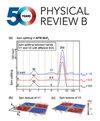Temperature-controlled strong magnon coupling in the van der Waals antiferromagnet CrCl3
IF 3.7
2区 物理与天体物理
Q1 Physics and Astronomy
引用次数: 0
Abstract
In van der Waals antiferromagnets, both magnetization and interlayer interactions are temperature dependent, and their combined effects significantly impact magnon dispersion. However, these effects remain largely unexplored. Here, we report the distinct temperature dependencies of the optical and acoustic magnon modes in a CrCl3 sample. We find that, below the范德华反铁磁体CrCl3中温度控制的强磁子耦合
在范德华反铁磁体中,磁化和层间相互作用都是温度相关的,它们的联合作用显著影响磁振子色散。然而,这些影响在很大程度上仍未被探索。在这里,我们报告了CrCl3样品中光学和声学磁振子模式的不同温度依赖性。我们发现,在nsamel温度下,光学模式随着温度的升高而变软,而声学模式对温度变化不敏感。我们将这一现象归因于易平面各向异性场和层间交换相互作用场对这两种磁振子模式的相反贡献。这些因素共同导致光学模式的软化,但在声学模式中相互补偿。通过利用两种磁振子模式相反的温度依赖关系,我们通过调节温度实现了它们之间的强耦合。这两种模式之间的耦合强度随外加磁场线性增加,对温度变化不敏感。我们的研究为范德华反铁磁体中温度控制的磁振子动力学提供了新的见解,并可能推进二维材料和异质结构的磁化研究。2025年由美国物理学会出版
本文章由计算机程序翻译,如有差异,请以英文原文为准。
求助全文
约1分钟内获得全文
求助全文
来源期刊

Physical Review B
物理-物理:凝聚态物理
CiteScore
6.70
自引率
32.40%
发文量
0
审稿时长
3.0 months
期刊介绍:
Physical Review B (PRB) is the world’s largest dedicated physics journal, publishing approximately 100 new, high-quality papers each week. The most highly cited journal in condensed matter physics, PRB provides outstanding depth and breadth of coverage, combined with unrivaled context and background for ongoing research by scientists worldwide.
PRB covers the full range of condensed matter, materials physics, and related subfields, including:
-Structure and phase transitions
-Ferroelectrics and multiferroics
-Disordered systems and alloys
-Magnetism
-Superconductivity
-Electronic structure, photonics, and metamaterials
-Semiconductors and mesoscopic systems
-Surfaces, nanoscience, and two-dimensional materials
-Topological states of matter
 求助内容:
求助内容: 应助结果提醒方式:
应助结果提醒方式:


